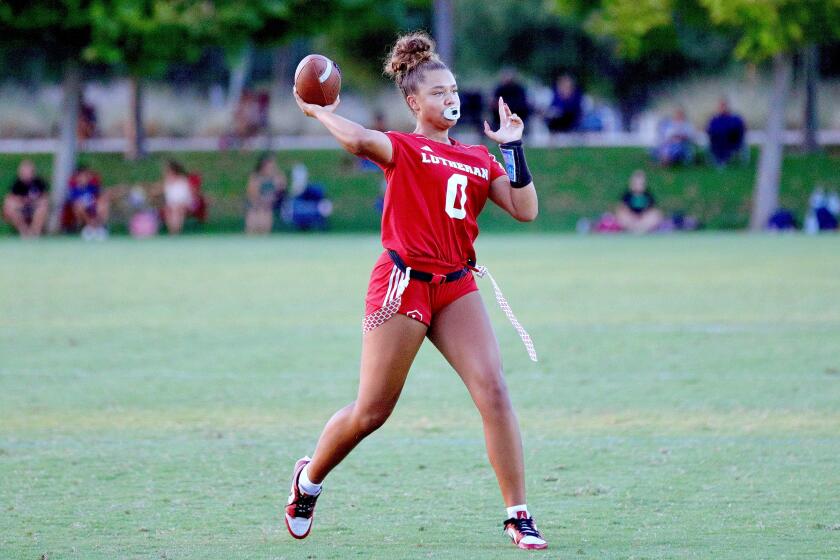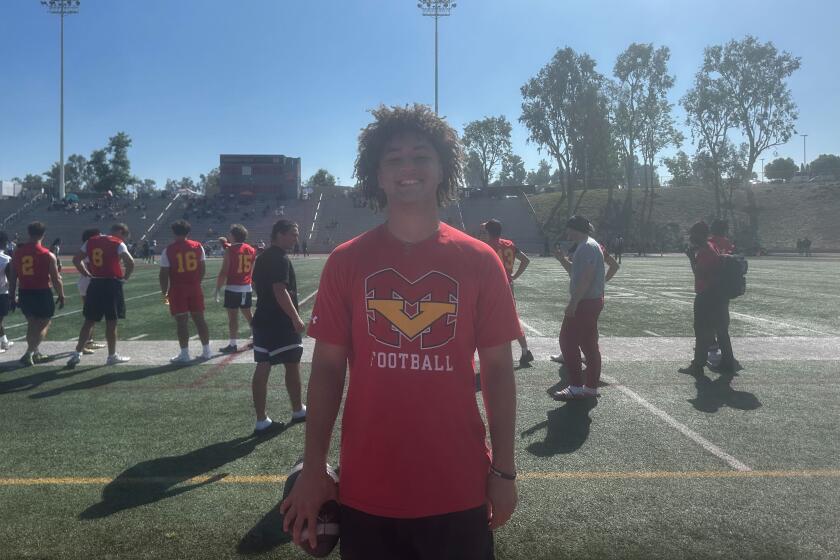Odgers Helps Athletes With Need for Speed
- Share via
Derrick Muska looked a bit uneasy, but that was understandable. He was about to become a human blur.
Standing on the UC Irvine track, the El Modena freshman checked the rip cord at his waist, glanced down the track and offered an uncertain nod.
Zooooooooooom.
He was Carl Lewis in a downhill 50. A cheetah on caffeine. He was hyperspeed, light speed and Speed Racer all rolled into one.
Or so went the illusion. Muska--taking part in the “Reaching Top Speed” clinic Saturday at UCI--was hooked up to a specially designed pulley system that, after a moderately paced build-up, pulls an athlete to 110% of his or her maximum speed. Picture being dragged on a leash by a very big dog, but without the embarrassment.
“It was,” said Muska, a basketball player, “kind of, uh . . . different.”
Just the reaction clinic organizers were hoping for, I’m sure.
Steve Odgers, strength and condition coach for the Chicago White Sox, created “Reaching Top Speed” to give high school athletes an affordable alternative to the high-priced, over-hyped private instruction marketed around Orange County. The five-hour clinic, staffed by Odgers, White Sox pitcher Kirk McCaskill and decathlete Jay Thorson, cost $30, including lunch and a T-shirt. Half the proceeds went to UCI’s track and field program.
Odgers, a former track standout at Edison High, Orange Coast College and UCI, said he offered the clinic because today’s high school athlete seems to have lost touch with basic running skills. The advent of video games, Odgers says, finally might have taken its toll. Look at the youth of today, and you’re looking at the Nintendo Generation.
That was evident in Odgers’ first clinic, held several weeks ago. Many of the 30 or so athletes who took part didn’t appear to be athletes at all. Some nearly tripped over themselves during the more basic movement drills.
Listen to a great athlete as he or she moves on the playing field, Odgers says. You won’t hear much. Stops and starts and smooth and quiet. The natural athlete bends, throws and turns with grace, not herky-jerky movements. Now check out your average high school football, baseball or basketball player. The differences can be extreme.
But the basics can be taught. Once taught, increased speed and quickness follow. Apparently, it works better than two candy bars and a Coke.
Odgers is big on warming up. Attend his clinic and you’re sweating and puffing before you do your first sprint. You jog, you run backward, sideways, do a couple 360-degree turns . . . by the time you’re finished, there’s no real need for the traditional sit-down-and-stretch. You’re that loose.
But on to the fun stuff. Odgers says to re-teach running, you have to teach proper posture. (A million or so drills later, you’ve got the idea down pat). Next, you get to practice running with a parachute billowing behind you. The drag helps enforce proper running mechanics. Besides, you get to feel like a Top Fuel dragster, and it looks real cool.
Odgers is a big believer in plyometrics. If you’re wondering what that is, know that it’s not a new form of geometry, it’s not a new style of music, as some of the 20 or so athletes gathered Saturday guessed.
Plyometrics, Odgers says, “are exercises using the elasticity of the muscles to create greater force or speed.” Remember the early 1980s dance, the Pogo? Picture that and go with it.
Jumping rope is a basic plyometric exercise, as is the standing broad jump. Jump from a standing position to the top of a box (about knee high) is a more advanced example, and Odgers cautions athletes to pace themselves accordingly. That goes for high school kids as well as professionals.
McCaskill says when he was with the Angels, conditioning meant some distance running, weight lifting and maybe a few flights of stadium stairs, three days a week. Now under Odgers’ guidance, his conditioning--all based on the skills learned in Saturday’s clinic--is a six-day-a-week affair.
“I can’t figure out what I used to do with all my spare time,” he said. “But I know now I’m a lot stronger. I’m a much more balanced athlete.”
That’s what happens when you stay off the Nintendo.
Barbie Ludovise’s column appears Wednesday, Friday and Sunday. Readers may reach Ludovise by writing her at The Times Orange County Edition, 1375 Sunflower Ave., Costa Mesa, 92626 or by calling (714) 966-5847.
More to Read
Get our high school sports newsletter
Prep Rally is devoted to the SoCal high school sports experience, bringing you scores, stories and a behind-the-scenes look at what makes prep sports so popular.
You may occasionally receive promotional content from the Los Angeles Times.






